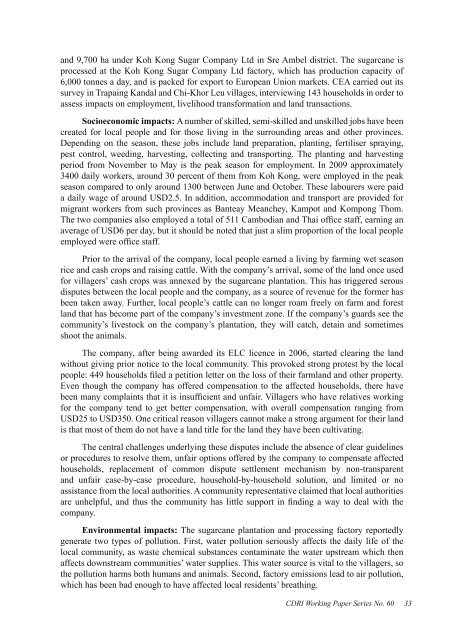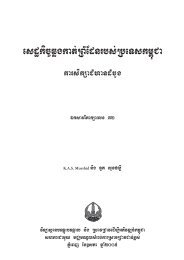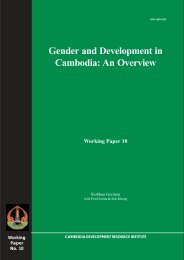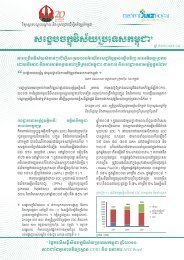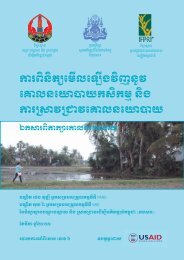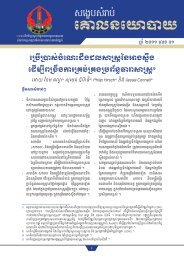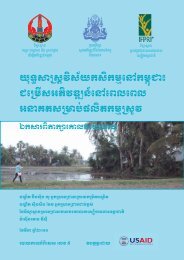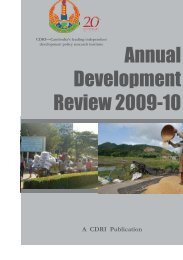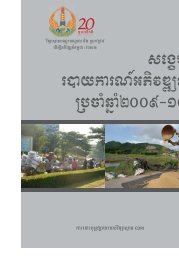Foreign Investment in Agriculture in Cambodia CDRI Working Paper ...
Foreign Investment in Agriculture in Cambodia CDRI Working Paper ...
Foreign Investment in Agriculture in Cambodia CDRI Working Paper ...
You also want an ePaper? Increase the reach of your titles
YUMPU automatically turns print PDFs into web optimized ePapers that Google loves.
and 9,700 ha under Koh Kong Sugar Company Ltd <strong>in</strong> Sre Ambel district. The sugarcane is<br />
processed at the Koh Kong Sugar Company Ltd factory, which has production capacity of<br />
6,000 tonnes a day, and is packed for export to European Union markets. CEA carried out its<br />
survey <strong>in</strong> Trapa<strong>in</strong>g Kandal and Chi-Khor Leu villages, <strong>in</strong>terview<strong>in</strong>g 143 households <strong>in</strong> order to<br />
assess impacts on employment, livelihood transformation and land transactions.<br />
Socioeconomic impacts: A number of skilled, semi-skilled and unskilled jobs have been<br />
created for local people and for those liv<strong>in</strong>g <strong>in</strong> the surround<strong>in</strong>g areas and other prov<strong>in</strong>ces.<br />
Depend<strong>in</strong>g on the season, these jobs <strong>in</strong>clude land preparation, plant<strong>in</strong>g, fertiliser spray<strong>in</strong>g,<br />
pest control, weed<strong>in</strong>g, harvest<strong>in</strong>g, collect<strong>in</strong>g and transport<strong>in</strong>g. The plant<strong>in</strong>g and harvest<strong>in</strong>g<br />
period from November to May is the peak season for employment. In 2009 approximately<br />
3400 daily workers, around 30 percent of them from Koh Kong, were employed <strong>in</strong> the peak<br />
season compared to only around 1300 between June and October. These labourers were paid<br />
a daily wage of around USD2.5. In addition, accommodation and transport are provided for<br />
migrant workers from such prov<strong>in</strong>ces as Banteay Meanchey, Kampot and Kompong Thom.<br />
The two companies also employed a total of 511 <strong>Cambodia</strong>n and Thai office staff, earn<strong>in</strong>g an<br />
average of USD6 per day, but it should be noted that just a slim proportion of the local people<br />
employed were office staff.<br />
Prior to the arrival of the company, local people earned a liv<strong>in</strong>g by farm<strong>in</strong>g wet season<br />
rice and cash crops and rais<strong>in</strong>g cattle. With the company’s arrival, some of the land once used<br />
for villagers’ cash crops was annexed by the sugarcane plantation. This has triggered serous<br />
disputes between the local people and the company, as a source of revenue for the former has<br />
been taken away. Further, local people’s cattle can no longer roam freely on farm and forest<br />
land that has become part of the company’s <strong>in</strong>vestment zone. If the company’s guards see the<br />
community’s livestock on the company’s plantation, they will catch, deta<strong>in</strong> and sometimes<br />
shoot the animals.<br />
The company, after be<strong>in</strong>g awarded its ELC licence <strong>in</strong> 2006, started clear<strong>in</strong>g the land<br />
without giv<strong>in</strong>g prior notice to the local community. This provoked strong protest by the local<br />
people: 449 households filed a petition letter on the loss of their farmland and other property.<br />
Even though the company has offered compensation to the affected households, there have<br />
been many compla<strong>in</strong>ts that it is <strong>in</strong>sufficient and unfair. Villagers who have relatives work<strong>in</strong>g<br />
for the company tend to get better compensation, with overall compensation rang<strong>in</strong>g from<br />
USD25 to USD350. One critical reason villagers cannot make a strong argument for their land<br />
is that most of them do not have a land title for the land they have been cultivat<strong>in</strong>g.<br />
The central challenges underly<strong>in</strong>g these disputes <strong>in</strong>clude the absence of clear guidel<strong>in</strong>es<br />
or procedures to resolve them, unfair options offered by the company to compensate affected<br />
households, replacement of common dispute settlement mechanism by non-transparent<br />
and unfair case-by-case procedure, household-by-household solution, and limited or no<br />
assistance from the local authorities. A community representative claimed that local authorities<br />
are unhelpful, and thus the community has little support <strong>in</strong> f<strong>in</strong>d<strong>in</strong>g a way to deal with the<br />
company.<br />
Environmental impacts: The sugarcane plantation and process<strong>in</strong>g factory reportedly<br />
generate two types of pollution. First, water pollution seriously affects the daily life of the<br />
local community, as waste chemical substances contam<strong>in</strong>ate the water upstream which then<br />
affects downstream communities’ water supplies. This water source is vital to the villagers, so<br />
the pollution harms both humans and animals. Second, factory emissions lead to air pollution,<br />
which has been bad enough to have affected local residents’ breath<strong>in</strong>g.<br />
<strong>CDRI</strong> Work<strong>in</strong>g <strong>Paper</strong> Series No. 60<br />
33


